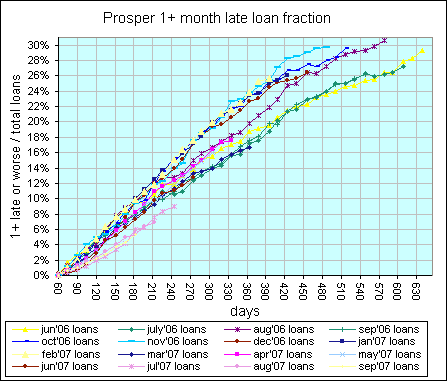 Peer-to-peer lending site LendingClub has a feature called LendingMatch that allows you build a portfolio of multiple notes simply by choosing a desired risk profile. Even though I’ve funded over 30 loans, I never touch the thing. Now, I think in general LC does a decent job rating their loans from A1-A5, B1-B5, all the way to G5. But sometimes I just don’t agree with their assessments, and other times I have a more personal objection to the loan. Today, I found an example that fit both.
Peer-to-peer lending site LendingClub has a feature called LendingMatch that allows you build a portfolio of multiple notes simply by choosing a desired risk profile. Even though I’ve funded over 30 loans, I never touch the thing. Now, I think in general LC does a decent job rating their loans from A1-A5, B1-B5, all the way to G5. But sometimes I just don’t agree with their assessments, and other times I have a more personal objection to the loan. Today, I found an example that fit both.
This loan passed through all of my usual manual filters. A/B grade only, 714+ credit score, debt-to-income ratio < 10%, and zero delinquencies within last two years. The assigned grade was A5, which is quite good overall.
But then I read the details. (If you’re a member, it’s loan #411092.) His reported gross income is $26,000 per year. He’s only been at his current job for only one year. He has been delinquent on accounts before, but last time was over 4 years ago. He has about $18,000 in credit card debt currently. He has 70% of his annual income as debt? To me, that’s like someone making $100k a year before taxes having $70,000 of consumer debt. Seems like quite a burden.
Already skeptical, I then read the loan description. Here it is, after I stripped out what I felt was not important:
This loan will be used to consolidate the remaining balance on two credit card balances and for home improvement. Looking to payoff some credit card debt and add a sunroom to my home. I am coming to the lending club community to help me build a nice sunroom to enjoy a cold glass of iced tea.
Honestly, I didn’t even know what a sunroom was until I looked it up. According to this site, a small 80 sq. ft. sunroom would cost from $5,000 to $15,000. He already has 70% of his gross annual income as debt, and he wants to add another $5,000 to it? That would result in a debt-to-annual income ratio of 90%.
I like the idea of helping people pay down their credit card debt by lowering their interest and consolidating into one payment. But this guy seems to really like being in debt. Now, that’s his choice, but I don’t like the idea of supporting it. Am I alone in thinking this way? I’m thinking I might not be, as his loan request didn’t fund the first time.
You can read about the other details of my LendingClub portfolio here. My annualized return after fees so far is 8.8%.


 I can’t stop the stock market from tumbling any further, but here’s a quick roundup of promotions by companies willing to pay you to try out their services. None of these listed require even a credit check. Additional information can be found through the links provided.
I can’t stop the stock market from tumbling any further, but here’s a quick roundup of promotions by companies willing to pay you to try out their services. None of these listed require even a credit check. Additional information can be found through the links provided. The Best Credit Card Bonus Offers – 2025
The Best Credit Card Bonus Offers – 2025 Big List of Free Stocks from Brokerage Apps
Big List of Free Stocks from Brokerage Apps Best Interest Rates on Cash - 2025
Best Interest Rates on Cash - 2025 Free Credit Scores x 3 + Free Credit Monitoring
Free Credit Scores x 3 + Free Credit Monitoring Best No Fee 0% APR Balance Transfer Offers
Best No Fee 0% APR Balance Transfer Offers Little-Known Cellular Data Plans That Can Save Big Money
Little-Known Cellular Data Plans That Can Save Big Money How To Haggle Your Cable or Direct TV Bill
How To Haggle Your Cable or Direct TV Bill Big List of Free Consumer Data Reports (Credit, Rent, Work)
Big List of Free Consumer Data Reports (Credit, Rent, Work)